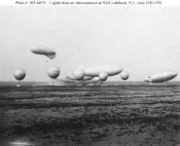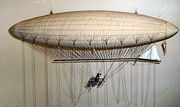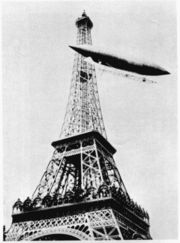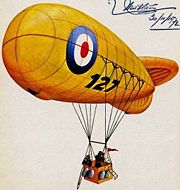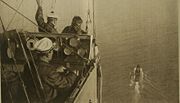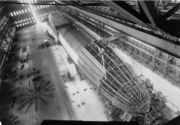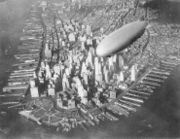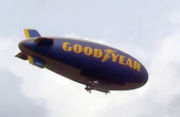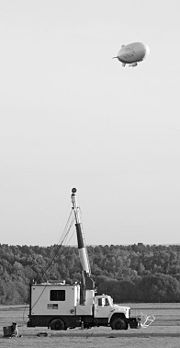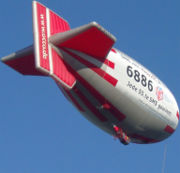Airship
2008/9 Schools Wikipedia Selection. Related subjects: Air & Sea transport
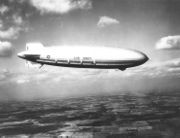
An airship or dirigible is a lighter than air ( buoyant) aircraft that can be steered and propelled through the air using rudders and propellers. Unlike other aerodynamic aircraft such as fixed-wing aircraft (airplanes) and helicopters, which produce lift by moving a wing or airfoil through the air, aerostatic aircraft, such as airships and hot air balloons, stay aloft by filling a large cavity, such as a balloon, with a lighter than air gas.
The main types of airship are Non-rigid airships (or blimps), semi-rigid airships and rigid airships. Blimps are small airships without internal skeletons. Semi-rigid airships are slightly larger and have some form of internal support such as a fixed keel. Rigid airships with a full skeleton, such as the massive Zeppelin transoceanic models, are now a thing of the past.
Airships were the first aircraft to make controlled, powered flight. They were widely used before the 1940s. Their use decreased over time as their capabilities were surpassed by those of airplanes. Their decline furthered with a series of high-profile accidents, including the 1937 burning of the hydrogen-filled Hindenburg near Lakehurst, New Jersey. Airships are still used today in certain niche applications, such as advertising and as a camera platform for sporting events.
Terminology
In many countries, airships are also known as dirigibles from the French (dirigir to direct plus -ible), meaning "directable" or steerable. The first airships were called dirigible balloons. Over time, the word balloon was dropped from the phrase. In the modern usage, balloon refers to buoyant aircraft that generally rely on wind currents for movement, though vertical movement can be controlled in both.
The term zeppelin is a genericised trademark that originally referred to airships manufactured by the Zeppelin Company. Their crafts' names were usually prefixed with the word Luftschiff, German for "airship".
In modern common usage, the terms zeppelin, dirigible and airship are used interchangeably for any type of rigid airship, with the terms blimp or airship alone used to describe non-rigid airships. Although the blimp also qualifies as a "dirigible", the term is seldom used with blimps. In modern technical usage, airship is the term used for all aircraft of this type, with zeppelin referring only to aircraft of that manufacture, and blimp referring only to non-rigid airships.
The term airship is sometimes informally used to mean any machine capable of atmospheric flight.
There is often some confusion around the term aerostat with regard to airships. This confusion arises because aerostat has two different meanings. One meaning of aerostat refers to all craft that remain aloft using buoyancy. In this sense, airships are a type of aerostat. The other, more narrow and technical meaning of aerostat refers only to tethered or moored balloons. In this second technical sense, airships are distinct from aerostats. This airship/aerostat confusion is often exacerbated by the fact that both airships and aerostats have roughly similar shapes and comparable tail fin configurations, although only airships have motors.
Types
- Non-rigid airships (blimps) use a pressure level in excess of the surrounding air pressure in order to retain their shape.
- Semi-rigid airships, like blimps, require internal pressure to maintain their shape, but have extended, usually articulated keel frames running along the bottom of the envelope to distribute suspension loads into the envelope and allow lower envelope pressures.
- Rigid airships ( Zeppelin is almost synonymous with this type) have rigid frames containing multiple, non-pressurized gas cells or balloons to provide lift. Rigid airships do not depend on internal pressure to maintain their shape and can be made to virtually any size.
- Metal-clad airships had characteristics of both rigid and non-rigid airships, utilizing a very thin, airtight metal envelope, rather than the usual rubber-coated fabric envelope. Only four ships of this type, Schwarz's aluminium ships of 1893 and 189 the ZMC-2 and the Slate "City of Glendale", have been built to date with only the ZMC-2 a success.
- Hybrid airship is a general term for an aircraft that combines characteristics of heavier-than-air (airplane or helicopter) and lighter than air technology. Examples include helicopter/airship hybrids intended for heavy lift applications and dynamic lift airships intended for long-range cruising. It should be noted that most airships, when fully loaded with cargo and fuel, are typically heavier than air, and thus must use their propulsion system and shape to generate aerodynamic lift, necessary to stay aloft; technically making them hybrid airships. However, the term "hybrid airship" refers to craft that obtain a significant portion of their lift from aerodynamic lift and often require substantial take-off rolls before becoming airborne.
Lifting gas
Any gas that is lighter than air can be used to create buoyant lift, however many such gases are either toxic, flammable, corrosive, or a combination of these, limiting their use in airships. Historically, hydrogen and helium have been used in large airships. A calculation based on the gas densities shows that hydrogen provides only 8% more lift than helium.
After the discovery of helium in the late 1890s, and development of processes to produce the gas commercially, helium was the preferred lifting gas. However until the 1950s, the United States was the sole producer of helium, and because the U.S. had embargoed exports of helium to Germany for strategic purposes since the 1920s, German airships were filled with hydrogen. The Hindenburg, for example, was originally designed to be filled with helium, but its unavailability forced the airship's operators to use hydrogen, with infamous results.
Ships called thermal airships utilize heated air, in a fashion similar to hot air balloons, as their lifting gas.
History
Early pioneers
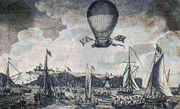
In 1784 Jean-Pierre Blanchard fitted a hand-powered propeller to a balloon, the first recorded means of propulsion carried aloft. In 1785, he crossed the English Channel with a balloon equipped with flapping wings for propulsion, and a bird-like tail for steerage.
The first person to make an engine-powered flight was Henri Giffard who, in 1852, flew 27 km (17 miles) in a steam-powered airship. Airships would develop considerably over the next two decades: In 1863, Dr. Solomon Andrews devised the first fully steerable airship, although it had no motor. In 1872, the French naval architect Dupuy de Lome launched a large limited navigable balloon, which was driven by a large propeller and the power of eight people. It was developed during the Franco-Prussian war, as an improvement to the balloons used for communications between Paris and the countryside during the Siege of Paris by German forces, but was only completed after the end of the war. Charles F. Ritchel made a public demonstration flight in 1878 of his hand-powered one-man rigid airship and went on to build and sell five of his aircraft. Paul Haenlein flew an airship with an internal combustion engine running on the coal gas used to inflate the envelope over Vienna, the first use of such an engine to power an aircraft in 1872.
In the 1880s a Serb named Ogneslav Kostovic Stepanovic also designed and built an airship. However the craft was destroyed by fire before it flew. In 1883, the first electric-powered flight was made by Gaston Tissandier who fitted a 1.5 hp (1 kW) Siemens electric motor to an airship. The first fully controllable free-flight was made in a French Army airship, La France, by Charles Renard and Arthur Constantin Krebs in 1884 . The 170-foot (52 m) long, 66,000 cubic foot (1,900 m³) airship covered 8 km (5 miles) in 23 minutes with the aid of an 8.5 hp (6 kW) electric motor.
In 1888-97, Dr. Frederich Wölfert built three Daimler Motor Company-built petrol engine powered airships, the last of which caught fire in flight and killed both occupants.
In 1896, a rigid airship created by Croatian engineer David Schwarz made its first flight at Tempelhof field in Berlin. After Schwarz's death, his wife, Melanie Schwarz, was paid 15,000 Marks by Count Ferdinand von Zeppelin for information about the airship.
In 1901, Alberto Santos-Dumont, in his airship "Number 6", a small blimp, won the Deutsch de la Meurthe prize of 100,000 francs for flying from the Parc Saint Cloud to the Eiffel Tower and back in under thirty minutes. Many inventors were inspired by Santos-Dumont's small airships and a veritable airship craze began world-wide. Many airship pioneers, such as the American Thomas Scott Baldwin financed their activities through passenger flights and public demonstration flights. Others, such as Walter Wellman and Melvin Vaniman set their sights on loftier goals, attempting two polar flights in 1907 and 1909, and two trans-atlantic flights in 1910 and 1912.
"The Golden Age"
The "Golden Age of Airships" began in July 1900 with the launch of the Luftschiff Zeppelin LZ1. This led to the most successful airships of all time: The Zeppelins. These were named after Count von Zeppelin who began experimenting with rigid airship designs in the 1890s leading to the badly flawed LZ1 (1900) and the more successful LZ2 (1906). At the beginning of World War I the Zeppelin airships had a framework composed of triangular lattice girders, covered with fabric and containing separate gas cells. Multi-plane, later cruciform, tail fins were used for control and stability, and two engine/crew cars hung beneath the hull driving propellers attached to the sides of the frame by means of long drive shafts. Additionally there was a passenger compartment (later a bomb bay) located halfway between the two cars.
First World War
The prospect of airships as bombers had been recognised in Europe well before the airships were up to the task. H. G. Wells The War in the Air (1908) described the obliteration of entire fleets and cities by airship attack. On 5 March 1912, Italian forces became the first to use dirigibles for a military purpose during reconnaissance west of Tripoli behind Turkish lines. It was World War I, however, that marked the airship's real debut as a weapon.
Albert Caquot designed an Observation Balloon for the French army in 1914. The Type R Observation balloon was used by all the allied forces, including the British and United States Armies, at the end of the World War. In 1919, Japan equipped the Imperial Army with several "Caquot dirigeables".
The Germans, French and Italians all operated airships in scouting and tactical bombing roles early in the war, and all learned that the airship was too vulnerable for operations over the front. The decision to end operations in direct support of armies was made by all in 1917. Count Zeppelin and others in the German military believed they had found the ideal weapon with which to counteract British Naval superiority and strike at Britain itself. More realistic airship advocates believed the Zeppelin was a valuable long range scout/attack craft for naval operations. Raids began by the end of 1914, reached a first peak in 1915, and then were discontinued in August 1918. Zeppelins proved to be terrifying but inaccurate weapons. Navigation, target selection and bomb-aiming proved to be difficult under the best of conditions. The darkness, high altitudes and clouds that were frequently encountered by zeppelin missions reduced accuracy even further. The physical damage done by the zeppelins over the course of the war was trivial, and the deaths that they caused (though visible) amounted to a few hundred at most. The zeppelins also proved to be vulnerable to attack by aircraft and antiaircraft guns, especially those armed with incendiary bullets. Several were shot down in flames by British defenders, and others crashed 'en route'. In retrospect, advocates of the naval scouting role of the airship proved to be correct, and the land bombing campaign proved to be disastrous in terms of morale, men and material. Many pioneers of the German airship service died in what was the first strategic bombing campaign in history. Countermeasures by the British were sound detection, equipment, search lights and anti-aircraft artillery, and starting in 1915 night fighters. One method used early in the war when short range meant the airships had to fly from forward bases, and when only Zeppelin production facilities were in Friedrichshafen, was bombing of airship sheds by the British Royal Naval Air Service. Late in the war, the development of the aircraft carrier led to the first successful carrier air strike in history. The morning of 19 July 1918, seven Sopwith 2F.1 Camels were launched from HMS Furious and struck the airship base at Tondern, destroying the Zeppelins L 54 and L 60.
Before the World War, the British Army was interested in blimps for scouting purposes. The Royal Navy recognizing the potential threat that scouting Zeppelins might pose, decided in 1908 to produce an example of rigid airship so that the threat might be evaluated in practice instead of theory. The Royal Navy was to continue development of rigid airships until the end of the war. The British Army abandoned airship development in favour of airplanes by the start of the war, but the Royal Navy had recognised the need for small airships to counteract the submarine and mine threat in coastal waters. Beginning in February 1915, began to deploy the SS (Sea Scout) class of blimp. These had a small envelope of 60-70,000 cu feet and at first utilised standard single engined planes (BE2c, Maurice Farman, Armstrong FK) shorn of wing and tail surfaces as control cars, an economy measure. Eventually more advanced blimps with purpose built cars, such as the C (Coastal), C* (Coastal Star), NS (North Sea), SSP (Sea Scout Pusher), SSZ (Sea Scout Zero), SSE (Sea Scout Experimental) and SST (Sea Scout Twin) classes were developed. The NS class, after initial teething problems proved to be the largest and finest airships in British service. They had a gas capacity of 360,000 cu feet, a crew of 10 and an endurance of 24 hours. Six 230 lb bombs were carried, as well as 3-5 machine guns. British blimps were used for scouting, mine clearance, and submarine attack duties. During the war, the British operated 226 airships, mostly non-rigid, most of which were of indigenous construction, though some non-rigid airships operated were purchased from France and even Germany (before the war). Of that number several were sold to Russia, France, the US and Italy. Britain, in turn, purchased one M-type semi-rigid from Italy whose delivery was delayed until 1918. Nine rigid airships had been completed by the armistice, although several more were in an advanced state of completion by the war's end. The large number of trained crews, low attrition rate and constant experimentation in handling techniques meant that at the war's end Britain was the world leader in non-rigid airship technology.
Both France and Italy continued airships throughout the war. France preferred non-rigid types while Italy operated 49 semi-rigid airships in both the scouting and bombing roles.
Airplanes had essentially replaced airships as bombers by the end of the war, and Germany's remaining zeppelins were scuttled by their crews, scrapped or handed over to the Allied powers as spoils of war. The British rigid airship program, meanwhile, had been largely a reaction to the potential threat of the German one and was largely, though not entirely, based on imitations of the German ships.
Inter-war period
Airships were operated in a number of nations between the two world wars. The major operators of rigid airships were Britain, the United States and Germany, and a few were operated by Italy and France. Italy, the Soviet Union, United States and Japan operated semi-rigid airships, while blimps were operated in many nations.

The British R33 and R34 were near identical copies of the German L 33, which crashed virtually intact in Yorkshire on September 24, 1916. Despite being almost three years out of date by the time they were launched in 1919, they were two of the most successful in British service. The creation of the Royal Air Force (RAF) in early 1918 created a hybrid British airship program. The RAF was uninterested in airships and the Admiralty was, so a deal was made where the Admiralty would design any future military airships while the RAF would handle manpower, facilities and operations.
After the armistice, the airship program was rapidly wound down, and rigid airship operations were curtailed. On July 2, 1919 R34 began the first double crossing of the Atlantic by an aircraft. It landed at Mineola, Long Island on July 6, 1919 after 108 hours in the air. The return crossing commenced on July 8 because of concerns about mooring the ship in the open, and took 75 hours. Impressed, British leaders began to contemplate a fleet of airships to link Britain to its far-flung colonies. But post-war economic conditions led to scrapping most airships and dispersion of trained personnel, until starting construction of the R-100 and R-101 in 1929. The major consequence of Britain's interest in establishing airship service to the empire was the effort to use the Allies' seizure of German airships and airship sheds to avoid competition from Germany. The US Navy contracted to buy the British built R-38, but before that airship was turned over to the US, it was lost to structural failure due to both improper design and operation.
The first American-built rigid dirigible was USS Shenandoah, christened on August 20 in Lakehurst, New Jersey. It flew in 1923, while the Los Angeles was under construction. It was the first ship to be inflated with the noble gas helium, which was still so rare that the Shenandoah contained most of the world's reserves. When the Los Angeles was delivered, the two airships had to share the limited supply of Helium, and thus alternated operating and overhauls.
The United States Navy purchased what became the USS Los Angeles and paid with "war reparations" money, owed according to the Versailles Treaty, thus saving The Zeppelin works. The success of the Los Angeles encouraged the US Navy to invest in its own, larger airships. The USS Los Angeles flew successfully for 8 years.
Meanwhile Germany was building the Graf Zeppelin, the largest airship that could be built in the company's existing shed, and intended to stimulate interest in passenger airships. The Graf Zeppelin burned blau gas, similar to propane, stored in large gas bags below the hydrogen cells, as fuel. Since its density was similar to that of air, it avoided the weight change when fuel was used, and thus the need to valve hydrogen. The "Graf" was a great success and compiled an impressive safety record. For example it flew over one million miles (including the first circumnavigation of the globe by air) without a single passenger injury.
The US Navy developed the idea of using airships as "flying aircraft carriers." There were two airships, the world's largest at the time, to test the principle—the USS Akron and USS Macon. Each carried four fighters in their "hanger", and could carry a fifth on the "trapeze." The "Flying Aircraft Carrier" had mixed results. By the time the Navy started to develop a sound doctrine for using the ZRS-type airships, the last of the two built, USS Macon, was lost. The seaplane had become more mature, and was considered a better investment.
Eventually the US Navy lost all three American-built rigid airships to accidents. USS Shenandoah on a poorly planned publicity flight flew into a severe thunderstorm over Noble County, Ohio on 3 September 1925. It broke into pieces, killing 14 of her crew. USS Akron was caught in a severe storm and flown into the surface of the sea off the shore of New Jersey on April 3, 1933. It carried no life boats and few life vests, so 73 of her 76-men crew died from drowning or hypothermia. USS Macon was lost after suffering a structural failure off the shore of Point Sur, California on 12 February 1935. The failure caused a loss of gas, which was made much worse when the aircraft was driven over pressure height causing it to lose too much helium to maintain flight. Only 2 of her 83-man crew died in the crash thanks to the inclusion of life jackets and inflatable rafts after the Akron disaster.
Britain's Burney Scheme and decline in airships
In Britain during the 1920s, Sir Denistoun Burney suggested a plan for air service throughout the Empire by airships (the Burney Scheme). Following the election of Ramsey MacDonald, the Burney scheme was transformed into a government-controlled program which contracted for two airships, one to be developed by the Airship Guarantee Company, the other by the Royal Airship Works. The two designs were radically different. The "capitalist" ship, the R100, was conservative, while the "socialist" ship, the R101, was wildly innovative. Construction was delayed, and the airships did not fly until 1929. Neither airship was capable of the service intended, though the R100 did complete a proving flight to Canada and back in 1930.
In October 1930 there were rushed preparations to fly the R-101, which had not been adequately tested and had serious deficiencies, on a flight to India carrying the Air Minister of the MacDonald government, Christopher Birdwell, Lord Thompson for an important Imperial conference. An air worthiness certificate was issued at the last moment. The R101 left on the flight on 5 October but hours later crashed in France killing 48 of the 54 people aboard. Because of the bad publicity surrounding the crash, the Air Ministry grounded the competing R100 in 1930 and sold it for scrap in 1931, ending the era of British rigid airships.
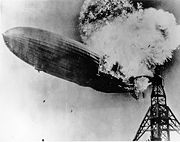
By the mid-1930s only Germany still pursued the airship. The Zeppelin company continued to operate the Graf Zeppelin on passenger service between Germany and Brazil. Even with the small Graf Zeppelin, the operation was almost profitable. In the mid-1930s work started to build an airship designed specifically to operate a passenger service across the Atlantic. The Hindenburg completed a very successful 1936 season carrying passengers between Lakehurst, New Jersey and Germany. But 1937 started with the most spectacular and widely remembered airship accident. Approaching the mooring mast minutes before landing on 6 May 1937, the Hindenburg burst into flames and crashed. Of the 97 people aboard, 36 died: 13 passengers, 22 aircrew, and one American ground-crewman. The disaster happened before a large crowd, was filmed and a radio news reporter was cutting a recording of his coverage of the arrival. This was a disaster which theatre goers could see and hear the next day. On that same next day, the Graf Zeppelin landed at the end of its flight from Brazil, ending intercontinental passenger airship travel.
Hindenburg's sister ship, the Graf Zeppelin II, could not fly without helium which the United States refused to sell. The Graf Zeppelin flew some test flights and conducted electronic espionage until 1939 when it was grounded due to the start of the war. The last two Zeppelins were scrapped in 1940.
Development of airships continued only in the United States, and in a small way, the Soviet Union.
Second World War
While Germany determined that airships were obsolete for military purposes in the coming war and concentrated on the development of airplanes, the United States pursued a program of military airship construction even though it had not developed a clear military doctrine for airship use. At the Japanese attack on Pearl Harbour on 7 December 1941 that brought the United States into World War II, it had 10 non-rigid airships:
- 4 K-class: K-2, K-3, K-4 and K-5 designed as a patrol ships built from 1938.
- 3 L-class: L-1, L-2 and L-3 as small training ships, produced from 1938.
- 1 G-class built in 1936 for training.
- 2 TC-class that were older patrol ships designed for land forces, built in 1933. The US Navy acquired them from Army in 1938.
Only K and TC class airships were suitable for combat and they were quickly pressed into service against Japanese and German submarines which were then were sinking US shipping within visual range of the US coast. US Navy command, remembering the airship anti-submarine success from World War I, immediately requested new modern anti-submarine airships and on 2 January 1942 formed the ZP-12 patrol unit based in Lakehurst from the 4 K airships. The ZP-32 patrol unit was formed from two TC and two L airships a month later, based at NAS Moffett Field in Sunnyvale, California. An airship training base was created there as well. In December 1941 and the first months of 1942, the Goodyear blimp Resolute was operated as an anti-submarine privateer based out of Los Angeles. As the only US craft to operate under a Letter of Marque since the War of 1812, the Resolute, armed with a rifle and flown by its civilian crew, patrolled the seas for submarines.
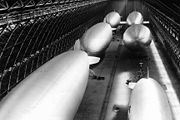
In the years 1942–44, approximately 1,400 airship pilots and 3,000 support crew members were trained in the military airship crew training program and the airship military personnel grew from 430 to 12,400. The US airships were produced by the Goodyear factory in Akron, Ohio. From 1942 till 1945, 154 airships were built for the US Navy (133 K-class, ten L-class, seven G-class, four M-class) and five L-class for civilian customers (serial number L-4 to L-8).
The primary airship tasks were patrol and convoy escort near the US coastline. They also served as an organisation centre for the convoys to direct ship movements, and were used in naval search and rescue operations. Rarer duties of the airships included aerophoto reconnaissance, naval mine-laying and mine-sweeping, parachute unit transport and deployment, cargo and personnel transportation. They were deemed quite successful in their duties with the highest combat readiness factor in the entire US air force (87%).
During the war some 532 ships without airship escort were sunk near the US coast by enemy submarines. Only one ship, the tanker Persephone, of the 89,000 or so in convoys escorted by blimps was sunk by the enemy. Airships engaged submarines with depth charges and, less frequently, with other on-board weapons. They were excellent at driving submarines down, where their limited speed and range prevented them from attacking convoys. The weapons available to airships were so limited that until the advent of the homing torpedo they had little chance of sinking a submarine.
Only one airship was ever destroyed by U-boat: on the night of 18/ 19 July 1943 a K-class airship (K-74) from ZP-21 division was patrolling the coastline near Florida. Using radar, the airship located a surfaced German submarine. The K-74 made her attack run but the U-boat opened fire first. K-74's depth charges did not release as she crossed the U-boat and the K-74 received serious damage, losing gas pressure and an engine but landing in the water without loss of life. The crew was rescued by patrol boats in the morning, but one crewman, Isadore Stessel, died from a shark attack. The U-Boat, U-134, was slightly damaged and the next day or so was attacked by aircraft sustaining damage that forced it to return to base. It was finally sunk on 24 August 1943 by a British Vickers Wellington near Vigo, Spain
Fleet Airship Wing One operated from Lakehurst, NJ, Glynco, GA, Weeksville, NC, South Weymouth NAS Massachusetts, Brunswick NAS and Bar Harbour ME, Yarmouth, Nova Scotia, and Argentia, Newfoundland.
Some US airships saw action in the European war theatre. The ZP-14 unit operating in the Mediterranean area from June 1944 completely denied the use of the Gibraltar Straits to Axis submarines. Airships from the ZP-12 unit took part in the sinking of the last U-Boat before German capitulation, sinking U-881 on 6 May 1945 together with destroyers Atherton and Mobery.
Other airships patrolled the Caribbean, Fleet Airship Wing Two, Headquartered at NAS Richmond, Florida, covered the Gulf of Mexico from Richmond and Key West, FL, Houma, Louisiana, as well as Hitchcock and Brownsville, Texas. FAW 2 also patrolled the northern Caribbean from San Julian, the Isle of Pines and Guantanamo Bay, Cuba as well as Vernam Field Jamaica.
Navy blimps of Fleet Airship Wing Five, (ZP-51) operated from bases in Trinidad, British Guiana and Parmaribo, Dutch Guiana. Fleet Airship Wing Four operated along the coast of Brazil. Two squadrons, VP-41 and VP-42 flew from bases at Amapá, Igarape Assu, Sao Luiz, Fortaleza, Fernando de Noronha, Recife, Maceiro, Ipitanga, Caravellas, Vitoria and the hanger built for the Graf Zeppelin at Santa Cruz.
Fleet Airship Wing Three operated squadrons, ZP-32 from Moffett Field, ZP-31 at NAS Santa Anna, and ZP-33 at Tillamook Oregon. Auxiliary fields were at Del Mar, Lompoc, Watsonville and Eureka, CA, North Bend and Astoria, Oregon, as well as Shelton and Quillayute in Washington.
From 2 January 1942 till the end of war airship operations in the Atlantic, the airships of the Atlantic fleet made 37,554 flights and flew 378,237 hours. Of the over 70,000 ships in convoys protected by blimps, only one was sunk by a submarine while under blimp escort.
The Soviet Union used a single airship during the war. The W-12, built in 1939, entered service in 1942 for paratrooper training and equipment transport. It made 1432 runs with 300 metric tons of cargo until 1945. On 1 February 1945 the Soviets constructed a second airship, a Pobieda-class (Victory-class) unit (used for mine-sweeping and wreckage clearing in the Black Sea) which crashed on 21 January 1947. Another W-class — W-12bis Patriot was commissioned in 1947 and was mostly used for crew training, parades and propaganda.
Modern use
Although airships are no longer used for passenger transportation, they are still used for other purposes such as advertising and sightseeing.
In June, 1987, the US Navy awarded a US$168.9 million contract to Westinghouse Electric and Airship Industries of the UK to demonstrate whether a blimp could be used as an airborne platform to detect the threat of sea-skimming missiles, such as the Exocet.
In recent years, the Zeppelin company has reentered the airship business. Their new model, designated the Zeppelin NT made its maiden flight on September 18, 1997. There are currently three NT aircraft flying. One was sold to a Japanese company, and was planned to be flown to Japan in the summer of 2004. But due to delays getting permission from the Russian government, the company decided to transport the airship to Japan by ship.
Blimps are used for advertising and as TV camera platforms at major sporting events. The most iconic of these is the Goodyear blimps. Goodyear operates 3 blimps in the United States, and the Lightship group operates up to 19 advertising blimps around the world. Airship Management Services owns and operates 3 Skyship 600 blimps. Two operate as advertising and security ships in the North America and the Caribbean.
Skycruise Switzerland AG owns and operates 2 skyship 600 blimps. One operates regularly over Switzerland used on sightseeing tours.
The Switzerland-based Skyship 600 has also played other roles over the years. For example, it was also flown over Athens during the 2004 Summer Olympics as a security measure. In November 2006, it carried advertising calling it "The Spirit of Dubai" as it began a publicity tour from London to Dubai, UAE on behalf of The Palm Islands, the worlds largest man-made islands created as a residential complex.
Los Angeles-based Worldwide Aeros Corp. produces FAA Type Certified Aeros 40D Sky Dragon airships.
In May 2006, US Navy began to fly airships again after a hiatus of nearly 44 years. The program uses a single American Blimp Company A-170 non-rigid airship. Operations focus on crew training and research, and the platform integrator is Northrop Grumman. The program is directed by the Naval Air Systems Command and is being carried out at NAES Lakehurst, the original centre of US Navy lighter-than-air operations in previous decades.
In November 2006, the US Army bought an A380+ airship from American Blimp Corporation through a Systems level contract with Northrop Grumman and Booz Allen Hamilton. The airship will start flight tests in late 2007 with a primary goal of carrying 2,500 lb of payload to an altitude of 15,000ft under remote control and autonomous waypoint navigation. The program will also demonstrate carrying 1,000 lb of payload to 20,000ft. The platform could be used for Multi-Intelligence collections. Northrop Grumman (formerly Westinghouse) has responsibility for the overall program.
Several companies, such as Cameron Balloons in Bristol, United Kingdom, build hot-air airships. These combine the structures of both hot-air balloons and small airships. The envelope is the normal 'cigar' shape, complete with tail fins, but is inflated with hot air (as in a balloon) to provide the lifting force, instead of helium. A small gondola, carrying the pilot (and sometimes between 1 and 3 passengers), a small engine and the burners to provide the hot air is suspended below the envelope, below an opening through which the burners protrude.
Hot-air airships typically cost less to buy and maintain than modern helium-based blimps, and can be quickly deflated after flights. This makes them easy to carry in trailers or trucks and inexpensive to store. They are usually very slow moving, with a typical top speed of 15-20 mph. They are mainly used for advertising, but at least one has been used in rainforests for wildlife observation, as they can be easily transported to remote areas.
Remote controlled (RC) airships, a type of Unmanned Aerial System (UAS), are sometimes used for commercial purposes such as advertising and aerial video and photography as well as recreational purposes. They are particularly common as an advertising mechanism at indoor stadiums. While RC airships are sometimes flown outdoors, doing so for commercial purposes is illegal in the US In particular, Docket FAA-2006-25714 states that: "The FAA recognizes that people and companies other than modelers might be flying UAS with the mistaken understanding that they are legally operating under the authority of AC 91-57. AC 91-57 only applies to modelers, and thus specifically excludes its use by persons or companies for business purposes."
Present-day research
Prototypes and experimental models
Hybrid designs such as the Heli-Stat airship/helicopter, the Aereon aerostatic/aerodynamic craft, and the Cyclocrane (a hybrid aerostatic/rotorcraft), have struggled to take flight. The Cyclocrane was also interesting in that the airship's envelope rotated along its longitudinal axis.
CL160 was a very large semi-rigid airship to be built in Germany by the start-up Cargolifter, but funding ran out in 2002 after a massive hangar was built. The hangar, built just outside Berlin, has since been converted into a resort called " Tropical Islands".
In 2005, a short-lived project of the US Defense Advanced Research Projects Agency (DARPA) was WALRUS HULA which explored the potential for using airships as long-distance, heavy lift craft. The primary goal of the research program was to determine the feasibility of building an airship capable of carrying 500 short tons (450 metric tons) of payload a distance of 12,000 miles (20,000 km) and land on an unimproved location without the use of external ballast or ground equipment (such as masts). In 2005, two contractors, Lockheed-Martin and US Aeros Airships were each awarded approximately $3 million to do feasibility studies of designs for WALRUS. In late March 2006, DARPA announced the termination of work on WALRUS after completion of the current Phase I contracts.
The US government is funding two major projects in the high altitude arena. The Composite Hull High Altitude Powered Platform (CHHAPP) is sponsored by US Army Space and Missile Defense Command. This aircraft is also sometimes called HiSentinel High-Altitude Airship. This prototype ship made a 5-hour test flight in September 2005. The second project, the high-altitude airship (HAA), is sponsored by DARPA. In 2005, DARPA awarded a contract for nearly $150 million to Lockheed-Martin for prototype development. First flight of the HAA is planned for 2008.
Many companies are working on high-altitude airships. Techsphere is developing a high-altitude version of their spherically shaped airships. JP Aerospace has discussed its long-range plans that include not only high altitude communications and sensor applications but also an " orbital airship" capable of lifting cargo into low Earth orbit with a marginal transportation cost of $1 per short ton per mile of altitude.
On January 31, 2006 Lockheed-Martin made the first flight of their secretly built hybrid-airship designated the P-791 at the company's flight test facility on the Palmdale Air Force Plant 42. The design is very similar in to the SkyCat, unsuccessfully promoted for many years by the now financially troubled British company Advanced Technology Group. Although Lockheed Martin is developing a design for the DARPA WALRUS HULA project, it claimed that the P-791 is unrelated to WALRUS. Nonetheless, the design represents an approach that may well be applicable to WALRUS. Some believe that Lockheed-Martin had used the secret P-791 program as a way to get a "head-start" on the other WALRUS competitor, Aeros.
A privately funded effort to build a heavy-lift aerostatic/aerodynamic hybrid craft, called the Dynalifter, is being carried out by Ohio Airships. Test flights are to begin in Spring 2006.
The research and development company for airship technologies, 21st century Airships Inc., has developed a spherical-shaped airship, and airships for high altitude, environmental research, surveillance and military applications, heavy lift and sightseeing. Its airships have set numerous world records.
In Russia AUGUR-RosAerosystems Group is manufacturing non-rigid multi-functional airships for up to 10 passengers, as well as patrol airships including the Au-12 and Au-30. They are also working on developmental programs for heavy-lift cargo models and high-altitude stratospheric ships. One of AUGUR-RosAeroSystems manufactured Au-30 airship will take part in the expedition to the North Pole challenged by famous French explorer Jean-Louis Etienne for arctic ice pack measurements in April, 2008.
Proposed designs and applications
Heavy lifting
The proposed Aeroscraft is Aeros Corporation's continuation of the now canceled WALRUS project. This proposed craft is a hybrid airship that, while cruising, obtains two thirds of its lift from helium and the remaining third aerodynamic lift. Jets would be used during take-off and landing.
Passenger transport
There is a case for the airship or zeppelin as a medium to long distance air 'cruise ship' using helium as a lifting agent. Airship passengers could have spacious decks inside the hull to give ample room for sitting, sleeping and recreation. There would be ample room for restaurants and similar facilities. The potential exists for a market in more leisurely journeys, such as cruises over scenic terrain.
Practical comparison to fixed-wing aircraft
The advantage of airships over airplanes is that static lift sufficient for flight is generated by the lifting gas and requires no engine power. This was an immense advantage before the middle of WW I and remained an advantage for long distance, or long duration operations until WW II. Modern concepts for high altitude airships include photovoltaic cells to reduce the need to land to refuel, thus they can remain in the air until consumables expire.
The disadvantages are that the drag on an airship rises as the square of its speed, while the power required to propel it increases as the cube of the speed. In airplanes, lift and drag increase together with speed, so that for a given lift the drag is effectually constant at any speed, and so the power required only increases linearly with speed until close to the speed of sound. Given the large flat plate area and wetted surface of the airship, a practical limit is reached somewhere between 80 and 100 mph (160 km/h). So the airship is not trusted with an important position by speed, but by durability as surveillance-gathering platform or other airborne early warning mission. In these cases, speed in not a critical need.
The altitude an airship can fly at largely depends on how much lifting gas it can lose due to expansion before stasis is reached. The ultimate altitude record for a rigid airship was set in 1917 by the L-55 under the command of Kurt Flemming (who later died in the Hindenburg) when he forced the airship to 24,000 feet (7,300 m) attempting to cross France after the "Silent Raid" on London. The L-55 lost lift as the descent to lower altitudes over Germany compressed the gas left in the cells, and thus the weight of air displaced. L-55 crashed due to loss of lift. While such waste of gas was necessary for the survival of airships in the later years of WW I, it was impractical for commercial operations, or operations of helium filled military airships. The highest flight made by a hydrogen filled passenger airship was 5,500 feet on the Graf Zeppelin's around the world flight. The practical limits for rigid airships was about 3,000 feet (900 m), and for pressure airships around 8,000 feet (2,400 m).
Modern airships use dynamic helium volume. At sea level altitude, helium only takes up a small part of the hull, while the rest volume is filled with air. As the airship ascends, the helium inflates with reduced outer pressure, and air is pushed out and released from the downward valve. This allows airships to reach any altitude with balanced inner and outer pressure, if the buoyancy is enough. Some civil aerostat could reach 100912 feet without explosion due to overloaded inner pressure.
The greatest disadvantage of the airship is size, which is essential to increasing performance. As size increases, the problems of ground handling increase geometrically. As the German Navy transitioned from the "p" class Zeppelins of 1915 (with a volume of over 1.1 million cubic feet) to the larger "q" class of 1916, the "r" class of 1917, and finally the "w" class of 1918, at almost 2.2 million cubic feet, ground handling problems reduced the number of days the Zeppelins were able to make patrol flights. This availability declined from 34% in 1915, to 24.3% in 1916 and finally 17.5% in 1918.
So long as the power-to-weight ratios of aircraft engines remained low and specific fuel consumption high, the airship had an edge for long range or duration operations. As those figures changed, the balance shifted rapidly in the airplane's favour. By mid-1917 the airship could no longer survive in a combat situation where the threat was airplanes. By the late 1930s, the airship barely had an advantage over the airplane on intercontinental over-water flights, and that advantage had vanished by the end of WW II.
This is in face-to-face tactical situation, current High Altitude Airship project is planned to survey hundreds of kimometers as their operation radius, often much farther than normal engage range of a military airplane. This provides better early warning, even farther than the Aegis system. The current Aegis system is often based on sea vessel like Ticonderoga Class and Burke Class, which have restricted radio horizon and line of sight. For example, a radar mounted on a 30 meter high vessel platform has radio horizon at 19.5 kilometers range, while a radar mounted on an 18000m altitude HAA has radio horizon at 478.1 kilometers range. This is significantly important for detecting low-flying cruise missiles or fighter-bombers.
The blimp remained a viable military system only until the conventional submarine was replaced by the nuclear submarine. Today, airships are used primarily for command, control and communication platform; to establish and maintain reliable and secure connectivity among all forces, provide transparent data across the echelons; precisely locate friendly and enemy forces; detect targets on an extended battlefield at a minimal exposure to enemy forces; real time targeting; navigation assistance; battle management; monitor radio conversations, ect. These are not tough combat missions.
Safety
The lift gas, helium, is not merely inert but acts as a fire extinguisher.
Modern airships have a natural buoyancy and special design that offers a virtually zero catastrophic failure mode. The internal hull pressure is maintained at only 1%-2% above surrounding air pressure, the vehicle is highly tolerant to physical damage or to attack by small arms fire or missiles.
While on long-haul flights weather patterns would be flown to avoid bad weather, the hull's mass largely dampens the effect of turbulence – just as a large tanker rides through rough seas.
An airship is usually a poor lightning target, as it is constructed mainly from composite materials. If it is struck, built-in protection devices minimise the risk to the vehicle and its cargo.
A series of structural vulnerability tests were done by the UK Defence Evaluation and Research Agency DERA on a Skyship 600, an earlier airship built by the Munk team to a similar pressure-stabilised design. Several hundred high-velocity bullets were fired through the hull, and even two hours later the vehicle would have been able to return to base. The airship is virtually impervious to automatic rifle and mortar fire: ordnance passes through the envelope without causing critical helium loss. In all instances of light armament fire evaluated under both test and live conditions, the vehicle was able to complete its mission and return to base.
